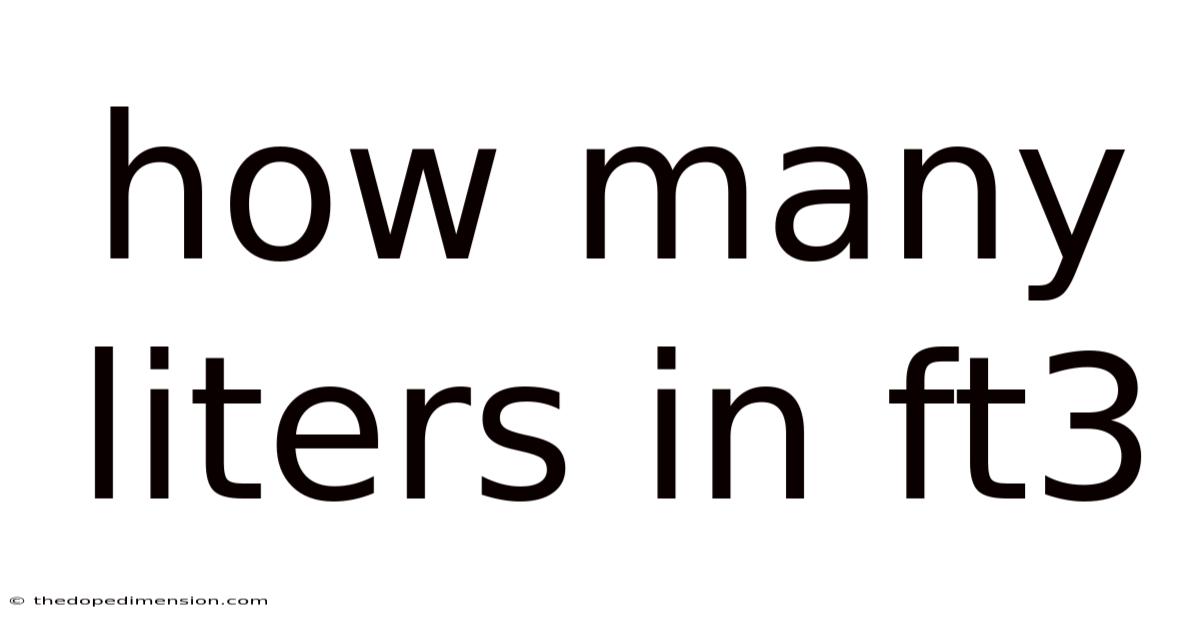How Many Liters In Ft3
thedopedimension
Aug 25, 2025 · 4 min read

Table of Contents
How Many Liters are in a Cubic Foot? Understanding Volume Conversions
Converting between units of volume, like liters and cubic feet (ft³), is a common task in various fields, from engineering and construction to cooking and everyday life. Understanding this conversion is crucial for accurate measurements and calculations. This comprehensive guide will delve into the conversion process, explain the underlying principles, and provide examples to solidify your understanding of how many liters are in a cubic foot. We'll also address frequently asked questions to ensure you gain a complete grasp of this important conversion.
Understanding Volume and Units
Before diving into the conversion, let's establish a clear understanding of volume and the units involved. Volume refers to the amount of three-dimensional space occupied by a substance or object. We'll focus on two key units:
-
Liters (L): A metric unit of volume, commonly used for liquids and gases. One liter is equivalent to 1 cubic decimeter (dm³).
-
Cubic Feet (ft³): An imperial unit of volume, representing the space occupied by a cube with sides of one foot each.
The Conversion Factor: From Cubic Feet to Liters
The conversion from cubic feet to liters isn't a simple multiplication by a single number. It involves a multi-step process due to the difference in the fundamental units of measurement (metric vs. imperial). The key is understanding the relationship between cubic feet, cubic meters, and liters.
-
Cubic Feet to Cubic Meters (m³): One foot is approximately 0.3048 meters (m). Therefore, one cubic foot is (0.3048 m)³ = 0.0283168 cubic meters.
-
Cubic Meters to Liters: Since one cubic meter (m³) is equal to 1000 liters (L), we can use this conversion factor.
-
Combining the Steps: To convert cubic feet directly to liters, we combine the two steps:
1 ft³ * (0.3048 m/ft)³ * (1000 L/m³) ≈ 28.3168 L
Therefore, one cubic foot is approximately equal to 28.3168 liters. This is the crucial conversion factor you'll use in all calculations.
Detailed Calculation and Examples
Let's illustrate the conversion process with a few examples:
Example 1: Converting a Small Volume
You have a container with a volume of 2.5 cubic feet. How many liters does it hold?
Calculation: 2.5 ft³ * 28.3168 L/ft³ ≈ 70.792 L
Therefore, a 2.5 ft³ container holds approximately 70.79 liters.
Example 2: Converting a Larger Volume
A swimming pool has a volume of 1500 cubic feet. What is its volume in liters?
Calculation: 1500 ft³ * 28.3168 L/ft³ ≈ 42475.2 L
The swimming pool's volume is approximately 42,475.2 liters.
Example 3: Reverse Conversion (Liters to Cubic Feet)
You have 500 liters of water. What is its volume in cubic feet?
To perform the reverse conversion, simply divide the volume in liters by the conversion factor:
500 L / 28.3168 L/ft³ ≈ 17.657 ft³
Therefore, 500 liters is approximately equal to 17.66 cubic feet.
Practical Applications and Considerations
The conversion between liters and cubic feet has numerous practical applications:
- Engineering and Construction: Calculating the volume of materials like concrete, soil, or water for projects.
- Aquariums and Fish Tanks: Determining the water capacity of aquariums and choosing appropriate filtration systems.
- HVAC Systems: Calculating the air volume handled by heating, ventilation, and air conditioning systems.
- Cooking and Baking: Converting recipes that use different units of volume.
Important Considerations:
-
Significant Figures: Pay attention to the number of significant figures in your calculations to avoid unnecessary precision. The conversion factor itself is an approximation, so it's usually sufficient to use a rounded value like 28.32 L/ft³ in most applications.
-
Accuracy: Remember that the conversion factor is an approximation because it relies on the approximate value of a foot in meters. For extremely high-precision applications, consult more precise conversion factors.
-
Units Consistency: Always ensure consistency in your units throughout your calculations. Mixing imperial and metric units can lead to errors.
Frequently Asked Questions (FAQ)
Q: Is the conversion factor of 28.3168 L/ft³ exact?
A: No, it's an approximation based on the approximate conversion between feet and meters. More precise conversions exist, but this value is accurate enough for most practical purposes.
Q: Can I use an online converter for this conversion?
A: Yes, many online converters are available for quickly converting between liters and cubic feet. However, understanding the underlying principles is essential for solving more complex problems.
Q: How do I convert cubic yards to liters?
A: First, convert cubic yards to cubic feet (1 cubic yard = 27 cubic feet), then use the conversion factor from cubic feet to liters.
Q: What about other volume units like gallons or milliliters?
A: You can convert between those units and cubic feet or liters using additional conversion factors readily available online or in reference materials.
Conclusion
Understanding the conversion between liters and cubic feet is a valuable skill with broad applications. By mastering the conversion factor of approximately 28.3168 liters per cubic foot and understanding the steps involved, you can confidently perform these conversions in various contexts. Remember to consider significant figures and unit consistency for accurate results. With practice and a solid grasp of the underlying principles, you’ll become proficient in navigating volume conversions and applying them to real-world problems. This knowledge will equip you to tackle various challenges involving volume calculations across diverse fields.
Latest Posts
Latest Posts
-
Mach To Feet Per Second
Aug 25, 2025
-
64 Bit Convert To Kb
Aug 25, 2025
-
Convert 68 Cm To Inches
Aug 25, 2025
-
How Many Inches Is 33mm
Aug 25, 2025
-
Watts To Btu Hr Conversion
Aug 25, 2025
Related Post
Thank you for visiting our website which covers about How Many Liters In Ft3 . We hope the information provided has been useful to you. Feel free to contact us if you have any questions or need further assistance. See you next time and don't miss to bookmark.